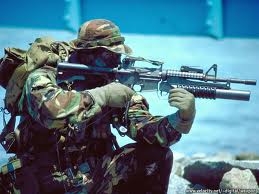U.S. Team Was Prepared to Fight Pakistani Forces
President Obama insisted that the assault force hunting down Osama bin Laden last week be large enough to fight its way out of Pakistan if confronted by hostile local police officers and troops, senior administration and military officials said Monday.
In revealing additional details about planning for the mission, senior officials also said that two teams of specialists were on standby: One to bury Bin Laden if he was killed, and a second composed of lawyers, interrogators and translators in case he was captured alive. That team was set to meet aboard a Navy ship, mostly likely the aircraft carrier Carl Vinson in the North Arabian Sea.
Mr. Obama’s decision to increase the size of the force sent into Pakistan shows that he was willing to risk a military confrontation with a close ally in order to capture or kill the leader of Al Qaeda.
Such a fight would have set off an even larger breach with the Pakistanis than has taken place since officials in Islamabad learned that helicopters filled with members of a Navy Seals team had flown undetected into one of their cities, and burst into a compound where Bin Laden was hiding.
One senior Obama administration official, pressed on the rules of engagement for one of the riskiest clandestine operations attempted by the C.I.A. and the military’s Joint Special Operations Command in many years, said: “Their instructions were to avoid any confrontation if at all possible. But if they had to return fire to get out, they were authorized to do it.”
The planning also illustrates how little the administration trusted the Pakistanis as they set up their operation. They also rejected a proposal to bring the Pakistanis in on the mission.
Under the original plan, two assault helicopters were going to stay on the Afghanistan side of the border waiting for a call if they were needed. But the aircraft would have been about 90 minutes away from the Bin Laden compound.
About 10 days before the raid, Mr. Obama reviewed the plans and pressed his commanders as to whether they were taking along enough forces to fight their way out if the Pakistanis arrived on the scene and tried to interfere with the operation.
That resulted in the decision to send two more helicopters carrying additional troops. These followed the two lead Black Hawk helicopters that carried the actual assault team. While there was no confrontation with the Pakistanis, one of those backup helicopters was ultimately brought in to the scene of the raid when a Black Hawk was damaged while making a hard landing.
“Some people may have assumed we could talk our way out of a jam, but given our difficult relationship with Pakistan right now, the president did not want to leave anything to chance,” said one senior administration official, who like others would not be quoted by name describing details of the secret mission. “He wanted extra forces if they were necessary.”
With tensions between the United States and Pakistan escalating since the raid, American officials on Monday sought to tamp down the divisions and pointed to some encouraging developments.
A United States official said that American investigators would soon be allowed to interview Bin Laden’s three widows, now being held by Pakistani authorities, a demand that Mr. Obama’s national security adviser, Thomas E. Donilon, made on television talk shows on Sunday.
American officials say the widows, as well as a review of the trove of documents and other data the Seals team collected from the raid, could reveal important details, not only about Bin Laden’s life and activities since he fled into Pakistan from Afghanistan in 2001, but also information about Qaeda plots, personnel and planning.
“We believe that it is very important to maintain the cooperative relationship with Pakistan precisely because it’s in our national security interest to do so,” said the White House spokesman, Jay Carney.


